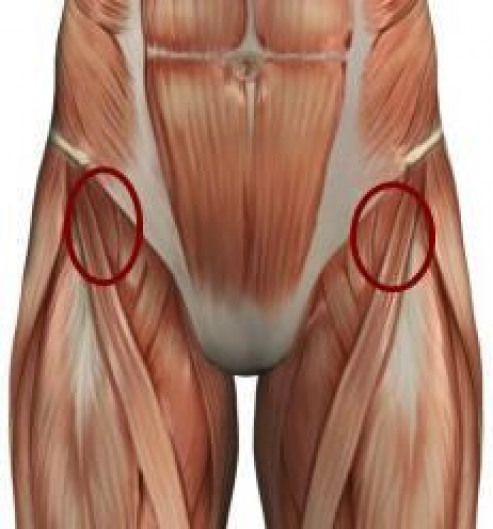Muscle attachments hip. Hip Muscles: Anatomy, Function, and Exercises for Optimal Performance
What are the main hip muscles and their functions. How do hip muscles contribute to movement and stability. Which exercises can strengthen hip muscles effectively. What are common hip muscle injuries and how to prevent them.
The Anatomy of Hip Muscles: Understanding the Powerhouse of Movement
The hip muscles play a crucial role in our ability to move, stabilize our body, and perform various activities. These muscles can be broadly categorized into several groups based on their location and function. Let’s dive deep into the intricate anatomy of hip muscles and explore their significance in our daily lives.
Key Movements of the Hip
Before we delve into specific muscles, it’s essential to understand the primary movements the hip joint can perform:
- Flexion: Moving the leg forward and upward
- Extension: Moving the leg backward and downward
- Abduction: Moving the leg outward, away from the body’s midline
- Adduction: Moving the leg inward, toward or across the body’s midline
- Rotation: Turning the leg inward or outward
Each hip muscle contributes to one or more of these movements, often working in synergy with other muscles to produce smooth, coordinated actions.
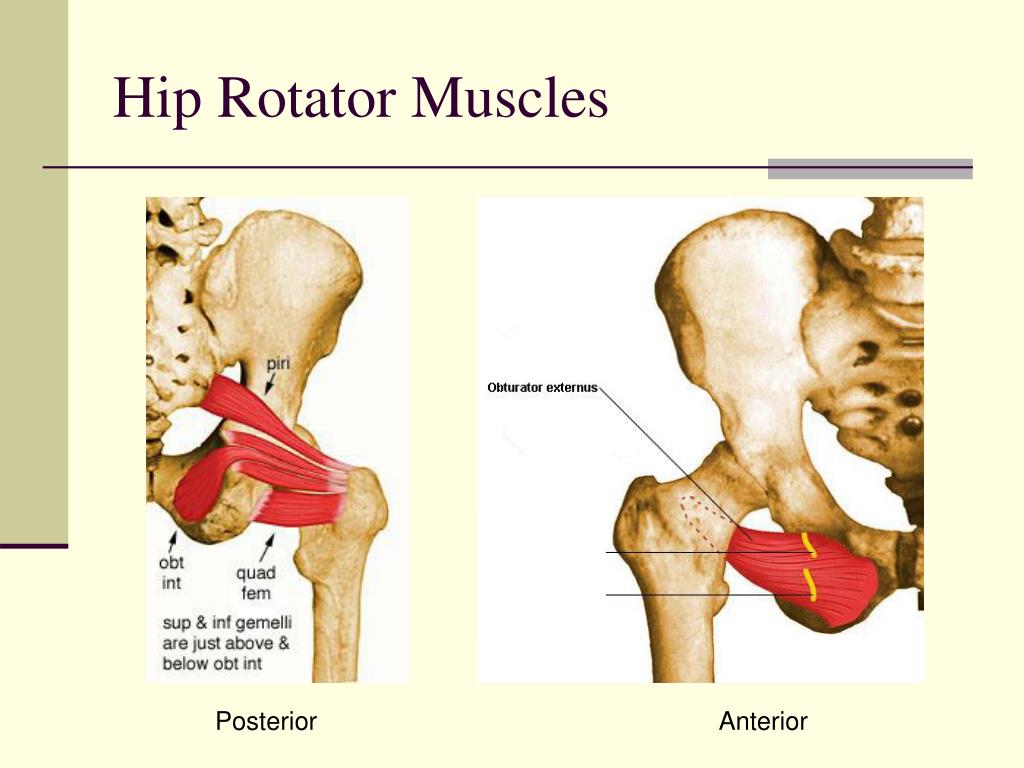
Hip Abductors: The Lateral Movers
Hip abductors are responsible for moving the leg away from the body’s midline. One of the key muscles in this group is the Tensor Fasciae Latae (TFL).
Tensor Fasciae Latae (TFL)
The TFL is a small but significant muscle located on the outer aspect of the hip. Here are its key characteristics:
- Origin: Anterior iliac crest and ilium
- Insertion: Lateral condyle of the tibia via the iliotibial band (ITB)
- Actions: Hip flexion and abduction
- Innervation: Superior gluteal nerve
The TFL plays a crucial role in activities like walking, helping to keep one foot in front of the other. Strengthening this muscle can be achieved through exercises such as standing hip abduction using a resistance band. To maintain flexibility, outer hip stretches are beneficial.
The Hamstring Group: Powerful Hip Extensors and Knee Flexors
The hamstring group consists of three muscles that span the back of the thigh and play a vital role in hip extension and knee flexion. These muscles are the semitendinosus, semimembranosus, and biceps femoris.

Semitendinosus
The semitendinosus is one of the three hamstring muscles. Its characteristics include:
- Origin: Ischial tuberosity
- Insertion: Upper medial surface of the tibia
- Actions: Hip extension, knee flexion, and internal rotation of the hip when the knee is flexed
- Innervation: Tibial part of the sciatic nerve
This muscle is essential for activities like bending the knee to step over objects. Strengthening exercises include knee curls with a resistance band and Nordic curls. To maintain flexibility, both sitting and standing hamstring stretches are effective.
Semimembranosus
The semimembranosus is the most medial of the three hamstring muscles. Its key features are:
- Origin: Ischial tuberosity
- Insertion: Posterior part of the medial condyle of the tibia
- Actions: Hip extension, knee flexion, and internal rotation of the hip when the knee is flexed
- Innervation: Tibial part of the sciatic nerve
Like the semitendinosus, this muscle is crucial for knee flexion and hip extension. Similar strengthening exercises and stretches apply to this muscle as well.

Biceps Femoris
The biceps femoris is unique among the hamstring group as it has two heads – a long head and a short head. This muscle is particularly important for both hip and knee movements.
Adductor Muscles: The Groin Powerhouses
The adductor muscles, located in the inner thigh, are responsible for pulling the legs together and play a crucial role in stabilizing the pelvis during walking and running.
Adductor Magnus
The adductor magnus is the largest of the adductor muscles and is often described as having two distinct parts:
- Origin:
- Adductor head: Inferior ramus of pubis and ischial ramus
- Hamstring head: Ischial tuberosity
- Insertion:
- Adductor head: Gluteal tuberosity, linea aspera, and proximal supracondylar line
- Hamstring head: Adductor tubercle of the femur
- Actions:
- Adductor head: Adduction, flexion, and medial rotation of the hip
- Hamstring head: Hip extension
- Innervation:
- Adductor head: Obturator nerve
- Hamstring head: Sciatic nerve
This muscle is particularly active in movements like bringing your second leg into a car. Strengthening can be achieved through hip adduction exercises using resistance bands, while flexibility can be improved with long adductor stretches.

Adductor Longus
The adductor longus is the middle of the three short adductor muscles. Its characteristics include:
- Origin: Superior pubic ramus, just below the crest
- Insertion: Middle third of the linea aspera of the femur
- Actions: Hip adduction and flexion
- Innervation: Obturator nerve
This muscle is crucial for movements that bring the legs together. Strengthening exercises and stretches similar to those for the adductor magnus are beneficial for this muscle as well.
Common Hip Muscle Injuries and Prevention Strategies
Hip muscle injuries can significantly impact mobility and quality of life. Understanding these injuries and how to prevent them is crucial for maintaining optimal hip function.
Hamstring Strains
Hamstring strains are common, especially in individuals with chronically tight hamstrings or those who don’t warm up adequately before physical activity. These injuries often occur during activities that involve sudden acceleration or deceleration, such as sprinting.
Prevention strategies include:
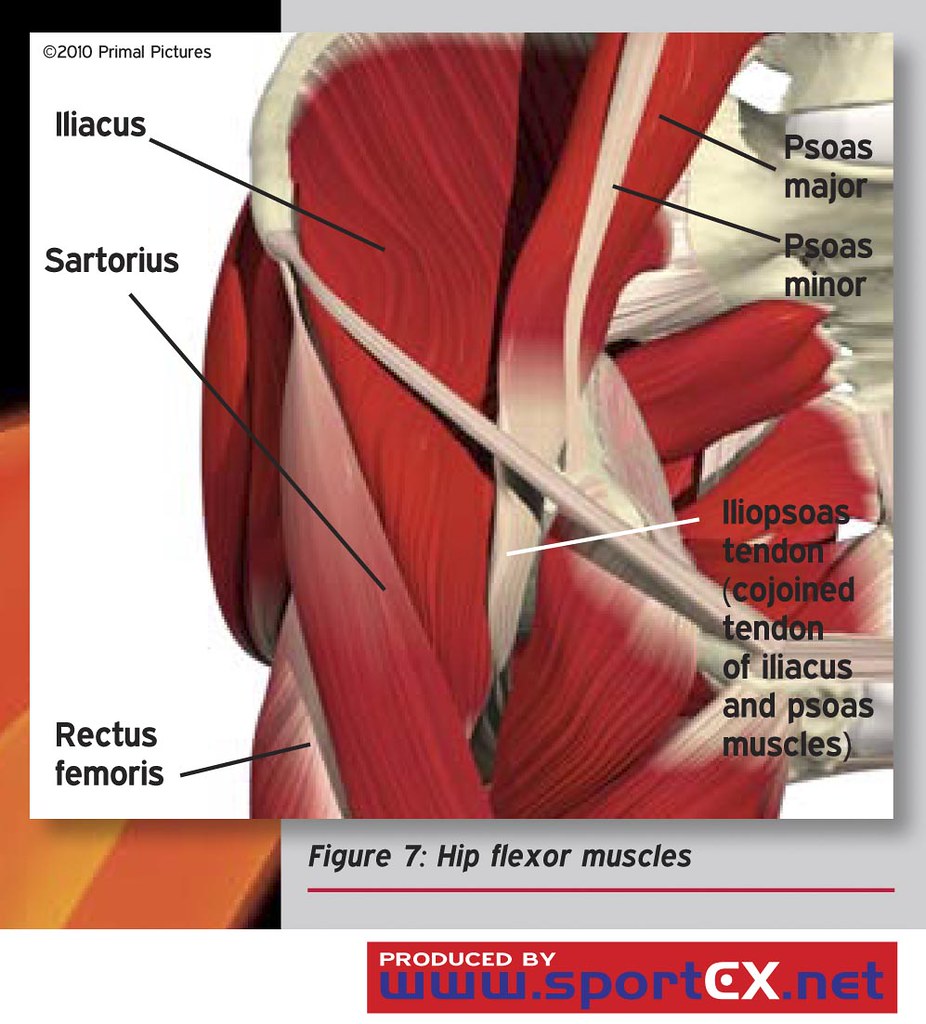
- Regular stretching to improve flexibility
- Proper warm-up before physical activity
- Strengthening exercises to improve muscle endurance and stability
- Gradual increase in exercise intensity to allow for muscle adaptation
Groin Strains
Groin strains typically affect the adductor muscles and are common in sports that require quick changes in direction, such as soccer or hockey. These injuries can occur due to overuse, inadequate warm-up, or muscle imbalances.
To prevent groin strains:
- Incorporate specific adductor strengthening exercises into your routine
- Ensure proper warm-up before activities that stress the groin muscles
- Maintain flexibility through regular stretching
- Address any muscle imbalances between the adductors and abductors
Effective Exercises for Strengthening Hip Muscles
Strengthening the hip muscles is crucial for maintaining proper joint function, improving athletic performance, and preventing injuries. Here are some effective exercises targeting different hip muscle groups:

Exercises for Hip Abductors
- Standing Hip Abduction with Resistance Band
- Loop a resistance band around your ankles
- Stand with feet hip-width apart
- Keeping your core engaged, lift one leg out to the side against the band’s resistance
- Lower slowly and repeat
- Side-Lying Leg Lifts
- Lie on your side with legs stacked
- Lift the top leg upward, keeping it straight
- Lower slowly and repeat
Exercises for Hamstrings
- Nordic Curls
- Kneel on a padded surface with someone holding your ankles
- Slowly lower your upper body forward, resisting with your hamstrings
- Use your arms to push back up to the starting position
- Single-Leg Romanian Deadlifts
- Stand on one leg, holding a weight in the opposite hand
- Hinge at the hips, lowering the weight toward the floor
- Keep your back straight and return to the starting position
Exercises for Adductors
- Standing Adduction with Resistance Band
- Loop a resistance band around one ankle and anchor it to a sturdy object
- Stand sideways to the anchor point
- Pull the banded leg across your body against the resistance
- Slowly return to the starting position and repeat
- Sumo Squats
- Stand with feet wider than shoulder-width, toes pointed outward
- Lower your body as if sitting back into a chair
- Keep your chest up and knees in line with your toes
- Push through your heels to return to the starting position
The Role of Hip Muscles in Athletic Performance and Daily Activities
Hip muscles play a crucial role in both athletic performance and everyday activities. Understanding their importance can help individuals optimize their training and movement patterns for improved function and reduced risk of injury.
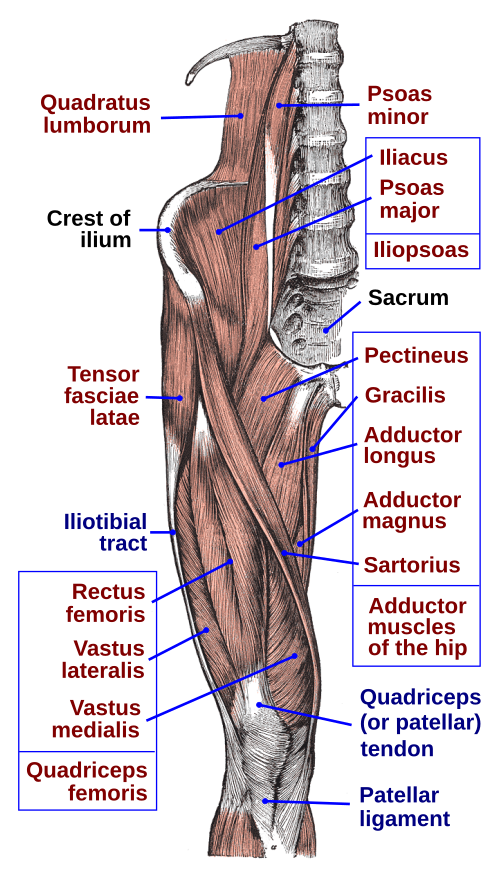
Athletic Performance
In sports and athletic activities, strong and flexible hip muscles contribute to:
- Improved speed and acceleration: Powerful hip extensors like the hamstrings and gluteus maximus are key for generating force during sprinting and jumping.
- Enhanced agility: Strong hip abductors and adductors allow for quick lateral movements and changes in direction.
- Increased stability: Well-developed hip muscles provide a stable base for upper body movements, crucial in sports like throwing or swinging a bat.
- Better endurance: Efficient hip muscle function can lead to improved running economy and reduced fatigue during prolonged activities.
Daily Activities
In everyday life, hip muscles are essential for:
- Walking and climbing stairs: Hip flexors and extensors work together to propel the body forward and lift the legs.
- Maintaining balance: Hip abductors play a crucial role in stabilizing the pelvis during single-leg stance, such as when putting on shoes.
- Sitting and standing: Hip extensors are key in rising from a seated position, while hip flexors assist in lowering into a chair.
- Bending and lifting: Proper hip hinge mechanics, facilitated by strong hip extensors, are crucial for safe lifting techniques.
Integrating Hip Muscle Training into a Comprehensive Fitness Program
To maximize the benefits of hip muscle training, it’s important to integrate these exercises into a well-rounded fitness program. Here are some tips for effective integration:

Balanced Approach
Ensure that your program addresses all major hip muscle groups:
- Include exercises for hip flexors, extensors, abductors, and adductors
- Balance strength training with flexibility work to maintain optimal muscle length and function
- Incorporate both isolated hip exercises and compound movements that engage multiple muscle groups
Progressive Overload
To continue seeing improvements, gradually increase the challenge of your hip exercises:
- Increase resistance (weights or band tension) as you get stronger
- Progress from bodyweight exercises to weighted versions
- Increase the number of sets or repetitions over time
Functional Integration
Incorporate exercises that mimic real-life movements or sport-specific actions:
- Include multi-planar movements that challenge the hips in different directions
- Use exercises that combine hip movements with core stability or upper body actions
- Practice sport-specific drills that heavily involve hip muscles
Recovery and Maintenance
Pay attention to recovery to prevent overuse injuries and maintain hip muscle health:
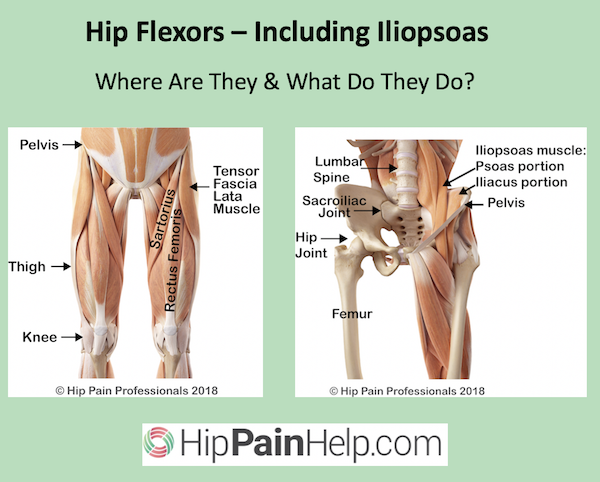
- Allow adequate rest between intense hip-focused workouts
- Use foam rolling and stretching to maintain muscle flexibility and reduce tension
- Consider incorporating yoga or Pilates to improve overall hip mobility and stability
By integrating these strategies into your fitness routine, you can develop strong, flexible, and functional hip muscles that support both athletic performance and daily activities. Remember to listen to your body and consult with a fitness professional or healthcare provider if you experience persistent hip pain or discomfort during exercise.
Hip Muscles – Origin, Insertion, Action and Exercises
April 19, 2023
The hip muscles include pelvic and groin muscles. They are important for stabilising the body and for moving the legs. Here we explain the hip and groin muscles, their actions and exercises.
Each of the hip muscles will have a main function, to produce a specific movement. However, often they will do more than one movement, assisting another muscle.
Movements of the hip
The movements available at the hip are:
Flexion
This is when you move your leg forwards and upwards.
Extension
This is the reverse of flexion, moving the leg down and backward.
Abduction
This is moving the leg out to the side.
Adduction
This is moving the leg inwards from the side and across the front of the body.
Hip abductors
These muscles abduct the hip. Abduction is the movement when you lift your leg up sideways, away from the midline of the joint.
Tensor Fascia Latae
The Tensor Fasciae Latae (TFL) is a small muscle on the outside of the hip. It attaches inferiorly (underneath/below) to the long thick strip of fascia, known as the iliotibial band (ITB).
- Origin: Anterior Iliac crest and ilium.
- Insertion: Lateral condyle of the tibia via the Iliotibial band.
- Actions: Flexion of the hip. Hip abduction.
- Innervation: Superior gluteal nerve.
- Daily uses: Keeping one foot in front of the other when walking.
- Example strengthening exercise: Standing hip abduction using a resistance band.
- Example stretches: Outer hip stretch. Standing outer hip stretch.
Advert
Arch Support Insoles
1000mile.co.uk (UK)
Amazon.com (USA)
Hip muscles which make the hamstring group
Semitendinosus
When running the hamstrings act eccentrically to slow down the knee extension motion. Hamstring strains are common in individuals with chronically tight hamstrings or who do not warm up thoroughly.
Hamstring strains are common in individuals with chronically tight hamstrings or who do not warm up thoroughly.
- Origin: Ischial tuberosity.
- Insertion: Upper medial surface of the tibia.
- Actions: Hip extension. Knee flexion. Internal rotation of the hip when the knee is flexed.
- Innervation: Tibial part of the sciatic nerve.
- Daily uses: Bending the knee to step over something.
- Example strengthening exercises: Knee curl with a resistance band.
Nordic curl. - Example stretches: Sitting hamstring stretch. Standing hamstring stretch.
Semimembranosus
Semimembranosus is the most medial of the three hamstring muscles. Chronically tight hamstrings are often a contributory factor to lower back pain and knee pain.
- Origin: Ischial tuberosity.
- Insertion: Posterior part of the medial condyle of the tibia.

- Actions: Hip extension. Knee flexion. Internal rotation of the hip when the knee is flexed.
- Innervation: Tibial part of the sciatic nerve.
- Daily uses: Bending the knee to step over something.
- Example strengthening exercises: Knee curl with a resistance band. Nordic curl eccentric exercise
- Example stretches: Sitting hamstring stretch. Standing hamstring stretch.
Biceps Femoris
Biceps Femoris is one of the three muscles which form the hamstring group forming the back of the thigh. The muscle is often described as having a long head (the attachment from the ischium) and a short head (attached to the femur).
Adductor hip muscles
Adductor Magnus
Adductor Magnus is the largest groin muscle and is one of the two long adductor muscles (gracilis is the other). It is usually described as having two parts, hamstring, and adductor parts.
- Origin: Adductor head: Inferior ramus of pubis and ischial ramus.
Adductor head: Inferior ramus of pubis and ischial ramus. - Insertion: Adductor head: Gluteal tuberosity, linea aspera, and proximal supracondylar line.
Hamstring head: Adductor tubercle of the femur. - Actions: Adductor head: Adducts, flexes and medially rotates the hip. Hamstring head: Extends hip.
- Innervation: Adductor head: Obturator nerve.
Hamstring head: Sciatic nerve. - Daily uses: Bringing your second leg into the car.
- Example strengthening exercises: Hip adduction using a resistance band.
- Example stretches: Long adductor stretch.
Adductor Longus
Adductor Longus is the middle of the three short adductor muscles. Groin strains are common injuries to the adductor muscles, which occur without a thorough warm-up or in individuals with chronically tight or weak adductor muscles.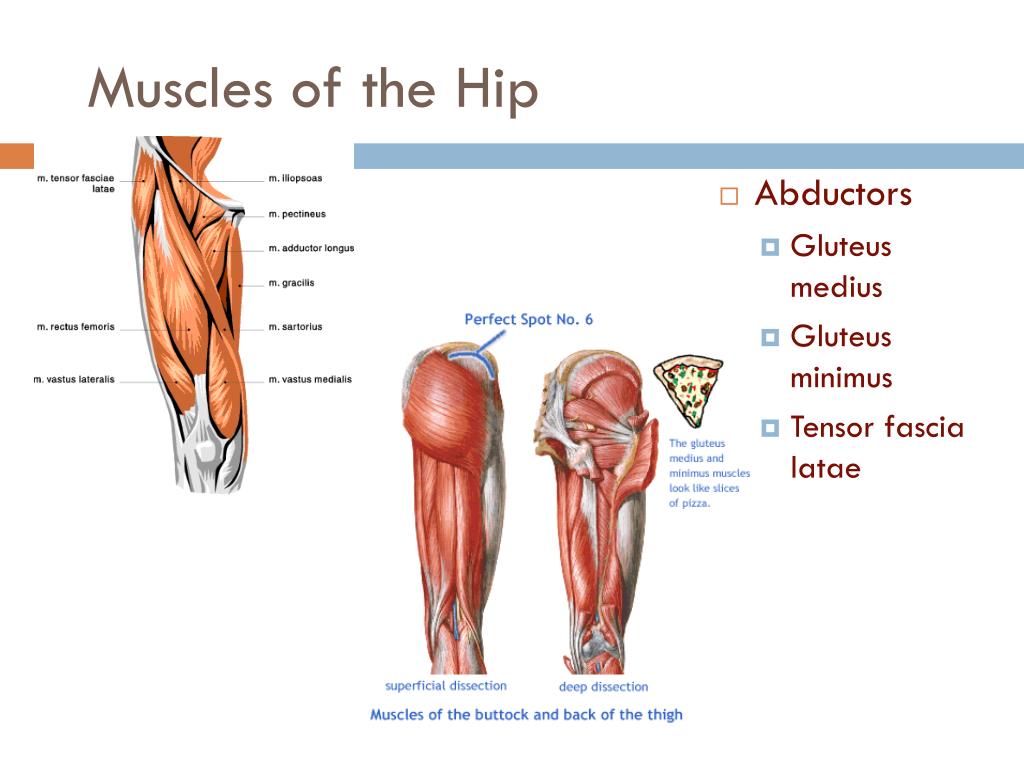
- Origin: Superior pubic ramus, just below the crest.
- Insertion: Middle third of the linea aspera of the femur.
- Actions: Hip adduction. Hip flexion.
- Innervation: Obturator nerve.
- Daily uses: Bringing your second leg into the car.
- Example Strengthening Exercises: Hip adduction using a resistance band.
- Example Stretches: Long adductor stretch.
Adductor Brevis
Adductor Brevis is the smallest and shortest (hence the name brevis, meaning short in latin) of the three short adductor muscles. Groin strains are common injuries to the adductor muscles, which occur without a thorough warm-up or in individuals with chronically tight or weak adductor muscles.
- Origin: Inferior ramus of the pubic bone Insertion.
Upper part of the linea aspera of the femur. - Actions: Hip adduction.
 Hip flexion.
Hip flexion. - Innervation: Obturator nerve.
- Daily uses: Bringing your second leg into the car.
- Example Strengthening Exercises: Isometric hip adduction. Hip adduction using a resistance band.
- Example Stretches: Short adductor stretch.
Pectineus
Pectineus is positioned between the Iliopsoas and Adductor Longus muscles and is part of the short adductor group with adductors brevis and longus.
- Origin: Upper front of the pubic bone.
- Insertion: Upper medial shaft of the femur, inferior to the lesser trochanter.
- Actions: Hip adduction. Hip flexion. Medial hip rotation.
- Innervation: Femoral nerve.
- Daily uses: Kicking a football.
- Example strengthening exercises: Isometric groin contraction. Hip adduction using a resistance band.
- Example stretches: Short adductor stretch.

Gracilis
Gracilis is another muscle that works in conjunction with the groin muscles or adductors.
External rotator hip muscles
These muscles primarily rotate the hip externally (outwards).
Piriformis Muscle
The Piriformis muscle is an important muscle. The sciatic nerve passes underneath this muscle on its route down to the posterior thigh. In some individuals, the nerve can actually pass right through the muscle. This can lead to sciatica symptoms due to a condition known as piriformis syndrome.
- Origin: Anterior surface of the lateral sacrum
- Insertion: Greater trochanter of the femur
- Actions: External rotation of the hip. Hip abduction.
- Innervation: Branch of the sacral plexus
- Daily uses: Taking the first leg out of the car
- Example strengthening exercises: Hip extension with external rotation
- Example stretches: Piriformis stretch
- Related injuries: Piriformis syndrome
- Related muscles: Gluteus minimus, gluteus medius, gluteus maximus
Hip flexor muscles
These muscle flex the hip. Hip flexion is moving the leg forwards and upwards. The rectus femoris is also a hip muscle as well as being one of the quadriceps.
Hip flexion is moving the leg forwards and upwards. The rectus femoris is also a hip muscle as well as being one of the quadriceps.
Iliopsoas
Iliopsoas is sometimes classified as two muscles, Iliacus and Psoas major, with Iliacus arising from the Ilium and Psoas from the vertebrae.
- Origin: Inner surface of the Ilium. Base of the sacrum.
Sides of the bodies of T12-L5. - Insertion: Lesser trochanter of the femur.
- Actions: Flexion of the hip. Lateral rotation of the hip. Flexing torso when the legs are fixed (e.g. lying to sitting).
- Innervation: Femoral nerve and branches of the lumbar plexus.
- Daily uses: Climbing a step.
- Example stretches: Hip flexor stretch.
- Example strengthening exercises: Isometric hip flexion. Standing hip flexion with a resistance band.
Gracilis
- Origin: Lower pubic body, near the pubic symphysis
- Insertion: Upper medial surface of the tibia (pes anserine insertion).

- Actions: Adducts hip.
Flexes knee.
Internally rotates the hip when the knee is flexed. - Innervation: Obturator nerve.
- Daily uses: Sitting with the knees pressed together.
- Example strengthening exercises: Hip adduction using a resistance band.
- Example stretches: Long adductor stretch.
Rectus femoris
The Rectus Femoris muscle is part of the Quadriceps muscle group. It is the only muscle of the group which crosses the hip joint and is a powerful knee extensor when the hip is extended but is weak when the hip is flexed.
- Origin: Anterior Inferior Iliac Spine (AIIS).
- Insertion: Top of the patella and the patella tendon to the tibial tuberosity.
- Actions: Flexion of the hip. Extension of the knee.
- Innervation: Femoral nerve.
- Daily uses: Kicking a football.

- Example strengthening exercises: Standing hip flexion using resistance band. Sitting hip flexion – isometric.
- Example stretches: Hip flexor stretch. Laying quadricep stretch. Standing quadricep stretch.
Sartorius Muscle
The Sartorius is a two-joint muscle and so is weak when the knee is flexed and the hip is flexed at the same time. It works better during single movements.
- Origin: Area between the ASIS (Anterior Superior Iliac Spine) and AIIS (Anterior Inferior Iliac Spine).
- Insertion: Anterior part of the medial condyle of the tibia.
- Actions: Flexion of the hip. Flexion of the knee. External rotation of the hip as it flexes the hip and knee.
- Innervation: Femoral nerve.
- Daily uses: Sitting in a cross-legged position.
- Example strengthening exercises: Standing hip flexion using resistance band.
 Isometric hip flexion.
Isometric hip flexion. - Example stretches: Hip flexor stretch. Laying quadricep stretch. Standing quadriceps stretch.
Gluteal muscles
Gluteus minimus
This is the smallest of the three gluteal muscles and sits underneath the gluteus medius.
- Origin: Outer surface of the ilium, below the origin of Gluteus medius.
- Insertion: Greater trochanter of the femur.
- Actions: Hip abduction. Internal rotation of the hip.
- Innervation: Superior gluteal nerve.
- Daily uses: Getting out of a car.
- Example strengthening exercises: Standing abduction using a resistance band.
- Example stretches: Outer hip stretch. Gluteal stretch.
Gluteus medius
Gluteus Medius is an important muscle in controlling the level of the hips. Weaknesses in gluteus medius often result in a Trendelenburg sign, an abnormal gait cycle where the hip of the swinging leg drops down, rather than raises up. This results in increased degrees of knee flexion in order to clear the ground.
This results in increased degrees of knee flexion in order to clear the ground.
- Origin: Outer surface of the ilium, just below the crest.
- Insertion: Greater trochanter of the femur.
- Actions: Hip abduction. Posterior fibres externally rotate the hip. Anterior fibres internally rotate the hip.
- Innervation: Superior gluteal nerve
- Daily uses: Stepping sideways out of the bath.
- Example strengthening exercises: Standing abduction using a resistance band.
- Example stretches: Outer hip stretch. Gluteal stretch.
Gluteus maximus
Gluteus Maximus is the largest and most superficial of the three gluteal muscles which forms the rounded shape of the buttocks.
- Origin: Posterior crest of the ilium.
Posterior surface of the sacrum. - Insertion: Gluteal tuberosity of the femur Iliotibial band (ITB).

- Actions: Hip extension.
External rotation of the hip. - Innervation: Inferior gluteal nerve.
- Daily uses: Extension phase of walking upstairs.
- Example strengthening exercises: Hip extension using a resistance band.
- Example stretches: Gluteus maximus stretch.
- Related injuries: Myofascial pain in the buttock muscles.
- Related muscles: Gluteus medius. Gluteus minimus.
Normal Hip Joint Anatomy & Total Hip Replacement 3D Videos, Houston Texas
The hip joint is the largest weight-bearing joint in the human body. It is also referred to as a ball and socket joint and is surrounded by muscles, ligaments and tendons. The thighbone or femur and the pelvis join to form the hip joint.
Any injury or disease of the hip will adversely affect the joint’s range of motion and ability to bear weight.
The hip joint is made up of the following:
- Bones and joints
- Ligaments of the joint capsule
- Muscles and tendons
- Nerves and blood vessels that supply the bones and muscles of the hip
The hip joint is the junction where the hip joins the leg to the trunk of the body. It is comprised of two bones: the thighbone or femur, and the pelvis, which is made up of three bones called ilium, ischium and pubis.
The ball of the hip joint is made by the femoral head while the socket is formed by the acetabulum. The acetabulum is a deep, circular socket formed on the outer edge of the pelvis by the union of three bones: ilium, ischium and pubis. The lower part of the ilium is attached by the pubis while the ischium is considerably behind the pubis. The stability of the hip is provided by the joint capsule or acetabulum and the muscles and ligaments that surround and support the hip joint.
The head of the femur rotates and glides within the acetabulum. A fibrocartilaginous lining called the labrum is attached to the acetabulum and further increases the depth of the socket.
A fibrocartilaginous lining called the labrum is attached to the acetabulum and further increases the depth of the socket.
The femur is one of the longest bones in the human body. The upper part of the thighbone consists of the femoral head, femoral neck, and greater and lesser trochanters. The head of the femur joins the pelvis (acetabulum) to form the hip joint. Next to the femoral neck, there are two protrusions known as greater and lesser trochanters which serve as sites of muscle attachment.
Articular cartilage is the thin, tough, flexible and slippery surface lubricated by synovial fluid that covers the weight-bearing bones of the body. It enables smooth movements of the bones and reduces friction.
Ligaments of the Hip Joint
Ligaments are fibrous structures that connect bones to other bones. The hip joint is encircled with ligaments to provide stability to the hip by forming a dense and fibrous structure around the joint capsule. The ligaments adjoining the hip joint include:
- Iliofemoral ligament: This is a Y-shaped ligament that connects the pelvis to the femoral head at the front of the joint.
 It helps in limiting over-extension of the hip.
It helps in limiting over-extension of the hip. - Pubofemoral ligament: This is a triangular shaped ligament that extends between the upper portion of the pubis and the iliofemoral ligament. It attaches the pubis to the femoral head.
- Ischiofemoral ligament: This is a group of strong fibers that arise from the ischium behind the acetabulum and merge with the fibers of the joint capsule.
- Ligamentum teres: This is a small ligament that extends from the tip of the femoral head to the acetabulum. Although it has no role in hip movement, it does have a small artery within that supplies blood to a part of the femoral head.
- Acetabular labrum: The labrum is a fibrous cartilage ring which lines the acetabular socket. It deepens the cavity increasing the stability and strength of the hip joint.
Muscles and Tendons of the Hip Joint
A long tendon called the iliotibial band runs along the femur from the hip to the knee and serves as an attachment site for several hip muscles including the following:
- Gluteal: These are the muscles that form the buttocks.
 There are three muscles (gluteus minimus, gluteus maximus, and gluteus medius) that attach to the back of the pelvis and insert into the greater trochanter of the femur.
There are three muscles (gluteus minimus, gluteus maximus, and gluteus medius) that attach to the back of the pelvis and insert into the greater trochanter of the femur. - Adductors: These muscles are in the thighs which help in adduction, the action of pulling the leg back towards the midline.
- Iliopsoas: This muscle is in front of the hip joint and provides flexion. It is a deep muscle that originates from the lower back and pelvis, and extends up to the inside surface of the upper part of the femur.
- Rectus femoris: This is the largest band of muscles located in front of the thigh. They are also called hip flexors.
- Hamstring muscles: These begin at the bottom of the pelvis and run down the back of the thigh. Because they cross the back of the hip joint, they help in extension of the hip by pulling it backwards.
Nerves and Arteries of the Hip Joint
Nerves of the hip transfer signals from the brain to the muscles to aid in hip movement. They also carry the sensory signals such as touch, pain, and temperature back to the brain.
They also carry the sensory signals such as touch, pain, and temperature back to the brain.
The main nerves in the hip region include the femoral nerve in the front of the femur and the sciatic nerve at the back. The hip is also supplied by a smaller nerve known as the obturator nerve.
In addition to these nerves, there are blood vessels that supply blood to the lower limbs. The femoral artery, one of the largest arteries in the body, arises deep in the pelvis and can be felt in front of the upper thigh.
Hip Movements
All the anatomical parts of the hip work together to enable various movements.Hip movements include flexion, extension, abduction, adduction, circumduction, and hip rotation.
Quadriceps femoris – KinesioPro
The quadriceps femoris (quadriceps) is the largest muscle in the human body. It is made up of four separate muscles: three broad muscles (medial, lateral, and intermediate) and the rectus femoris. They form the bulk of the thigh and together are one of the most powerful muscles in the human body.
Clinically Relevant Anatomy
Origin and Insertion
The quadriceps muscles are attached to the patella by the quadriceps tendon. In turn, the patella is attached to the tibia by the patella ligament.
Vascularis lateralis muscle (LSM) of the thigh
- Origin: the muscle originates from the greater trochanter and lateral lip of the rough line of the femur.
- Function: extends the knee joint and stabilizes the patella.
Intermediate vastus muscle (VSM) of the thigh
- Origin: anterior and lateral surfaces of the body of the femur.
- Function: extends the knee and stabilizes the patella.
Vascular medial muscle (MSM) of the thigh
- Origin: intertrochanteric line and medial lip of the rough line of the femur.
- Function: extends the knee joint and stabilizes the patella, especially due to the horizontal fibers of the distal part of the muscle.
Read also the article: Angle Q.
Rectus femoris muscle (MP)
- Beginning: the muscle originates from the lower anterior iliac spine, just above the acetabulum, runs straight along the body of the femur (Latin word ” straight” – rectus) and is attached to the patella by the tendon of the quadriceps femoris muscle.
- Function: Flexes the hip and extends the knee (the only quadriceps muscle that crosses the hip and knee joints).
These muscles are innervated by the femoral nerve (L2, L3, L4).
Blood supply: femoral artery, deep femoral artery.
Function
Knee extension
All quadriceps muscles extend the knee. The hip PM also flexes the hip at the hip joint. The LSM of the thigh adducts the thigh, and also participates in its extension and external rotation.
- The quadriceps are mainly used during kicking, jumping (basketball), cycling and running.
- In daily life, these muscles help you get up from a chair, walk, climb stairs and squat.

- In the walking cycle, the muscles are most active during the swing phase; they are also active during the descent downhill.
Clinical Significance
From an athletic point of view, this is an extremely important muscle, but due to the stress it is under, it is often injured. Strains, tears and bruises of the quadriceps are common in various sports such as athletics, rugby, football, etc., and lead to a change in training regimen and the inability to participate in competitions. A quadriceps injury, not to mention a deterioration in athletic performance, can be quite painful and debilitating.
Friends, Dmitry Gorkovsky’s seminar “Myofascial release (a scientific approach to increasing joint mobility)” will take place very soon. Learn more…
Myositis ossificans is a complication that can occur in connection with severe contusions of the quadriceps muscle. This is a neoplastic proliferation of bones and cartilage in the area of injury. With bruises, the incidence ranges from 9% to 17%. The condition should be suspected if symptoms worsen after 2–3 weeks, with impaired knee flexion and persistent edema.
With bruises, the incidence ranges from 9% to 17%. The condition should be suspected if symptoms worsen after 2–3 weeks, with impaired knee flexion and persistent edema.
Adaptation of the quadriceps muscle in the presence of disease
Skeletal muscles change in the presence of chronic disease. This means that the functions of the muscle may be impaired due to changes in metabolism and its own structure.
- Chronic obstructive pulmonary disease (COPD) and chronic heart failure
The presence of chronic respiratory diseases, such as COPD, determines the decrease in quadriceps mass, as well as an increase in connective tissue and fibrosis phenomena. This results in decreased contractility, decreased strength, and reduced balance when walking or standing. Anaerobic fibers increase due to oxidative fibers; muscles get tired more easily. There is also an increase in intramuscular fat with local and systemic metabolic changes (increased cardiovascular risk). Women suffer more from functional muscle changes than men.
Women suffer more from functional muscle changes than men.
- Multiple sclerosis
In multiple sclerosis, the quadriceps muscle loses its mass and strength, which is accompanied by a decrease in oxidative fibers and an increase in anaerobic fibers. Although there is an increase in the number of white fibers, the latter are characterized by greater atrophy. Increased intramuscular fat and fibrous processes.
- Aging
Age adaptation of the quadriceps muscle is accompanied by changes in its morphology and function. The muscle loses mass and volume (sarcopenia), strength and coordination decrease. Motor units are lost (denervation processes increase), while the percentage of red fibers increases. The processes of fibrosis and accumulation of intramuscular fat also increase.
Evaluation
After taking the history, a thorough examination should be performed, including examination, palpation, assessment of strength and movement. Injuries to the quadriceps muscle may be accompanied by obvious deformity, such as a bulge or defect in the belly of the muscle.
Injuries to the quadriceps muscle may be accompanied by obvious deformity, such as a bulge or defect in the belly of the muscle.
- Palpation of the anterior thigh should include assessment of the size of the injured muscle, localization of the area of maximum tenderness, and search for any defect in the muscle.
- The quadriceps strength test should include assessment of resistance to knee extension and hip flexion. Adequate testing of the hip PM should include assessment of resistance to knee extension during hip flexion and extension. This is best done by assessing the patient both in the sitting and lying position. The person is asked to extend the leg at the knee against external resistance. If the femoral nerve is damaged, there will be no quadriceps contraction. The prone position also allows you to optimally assess the mobility and elasticity of the quadriceps muscle.
- Pain is usually felt by the patient with resistance to muscle activation, passive stretching, and direct palpation of the injury site.

- Identification of soreness, any palpable defect and strength at the onset of the disease allows you to determine the severity of the injury and clarify the direction for further examination and treatment.
- Evaluation of the quadriceps for imbalance suggests problems with the patella. It is also necessary to examine the patient in order to identify an imbalance between quadriceps and hamstrings.
- The quadriceps muscle can be used to test the femoral nerve.
- Functional tests include the Get Up and Walk Test and Stair Climbing Test.
Functional coordination between the vastus muscles of the thigh
Myoelectrical balance of the quadriceps muscle is essential for proper movement of the patella.
Proprioceptive muscle afferents help maintain adequate posture. Recent studies suggest that activation of these afferents allows the contralateral quadriceps muscle to improve its coordination and thus postural balance.
The thigh PM can activate its fibers in the longitudinal mode. It can also activate proximal fibers in the absence of distal fiber contraction. If quadriceps activity persists, then the most distal fibers are activated, while the most proximal fibers are not active (which is probably due to a mechanism that slows down the onset of fatigue).
It can also activate proximal fibers in the absence of distal fiber contraction. If quadriceps activity persists, then the most distal fibers are activated, while the most proximal fibers are not active (which is probably due to a mechanism that slows down the onset of fatigue).
Femoral LSM contributes little to the patellar tendon, so it is not able to generate enough force to medially stabilize the patella during knee extension. In fact, during its contraction, it pulls on the aponeurosis of the FSM of the thigh, counteracting the lateral forces on the patella generated by the LSM of the thigh. The LSM of the femur acts as an indirect stabilizer of the patella, concentrating its force along the median axis of the femur.
The force generated by the LBM of the thigh increases with increasing knee flexion angle. This mechanism is due to the length of the fibers compared to the connective tissue structure of the muscle. Longer fibers are characterized by greater strength and better elasticity or resistance of the connective tissue. When the knee is extended, the LBM of the thigh generates a small force that allows the position to be maintained with minimal effort.
When the knee is extended, the LBM of the thigh generates a small force that allows the position to be maintained with minimal effort.
Source: Physiopedia – Quadriceps Muscle.
FUNCTIONAL ANATOMY OF THE MUSCULAR SYSTEM | Thigh abductors
Nikita Yushchenko (author)
MUSCLES OF THE LOWER LIMB – abductors of the hip
The muscles of hip abduction cross the hip joint and are located on its lateral side. They are attached mainly to the greater trochanter.
Hip abductor muscles include :
- gluteus medius;
- gluteus minimus;
- pear-shaped;
- obturator internal;
- twin;
- tensor fascia lata (see hip flexors).

1. Gluteus medius is partially covered by the gluteus maximus. It starts from the outer surface of the ilium and the broad fascia of the thigh, and is attached to the greater trochanter.
Gluteus medius :
- Abducts the thigh.
- Also, due to the fact that the anterior fibers of the muscle go from top to bottom and back, and the posterior ones – from top to bottom and forward, it takes part in both pronation and supination of the thigh.
2. Gluteus minimus is located under the gluteus medius. It starts from the ilium and is attached to the greater trochanter.
Gluteus minor :
- Abducts the hip.
3. The piriformis muscle originates on the anterior surface of the sacrum, passes through the foramen magnum into the gluteal region, and inserts at the apex of the greater trochanter.
Piriformis :
- Abducts the thigh.

- Supinates the thigh.
4. The obturator internus muscle is located inside the small pelvis. It starts from the obturator membrane, goes to the lateral side, bends through the lesser sciatic notch, enters the gluteal region and attaches to the trochanteric fossa.
5. Upon its exit from the small pelvis, the upper and lower twin muscles are attached to the tendon of the obturator internus muscle , lying above and below it. These two small muscles originate from the ischial spine (upper muscle) and the ischial tuberosity (lower muscle).
- The function of the obturator internus and gemellius muscles is to abduct the hip if the pelvis is fixed, and in a standing position on one leg, to keep the pelvis from tilting towards the opposite leg.
- In addition, these muscles are also involved in the supination of the thigh.
The main role in hip abduction is played by the gluteus medius, and its anterior and middle sections perform abduction to a greater extent than the posterior one.


 Hip flexion.
Hip flexion.


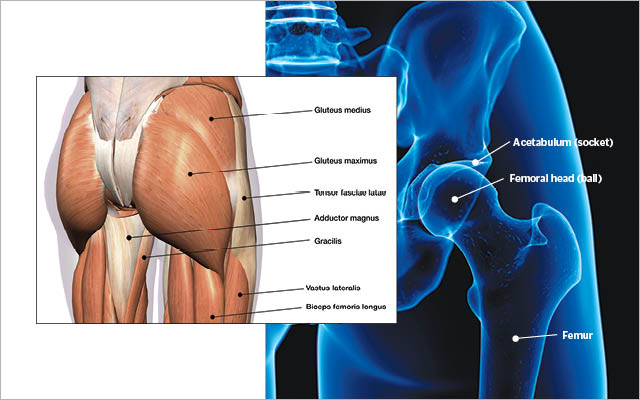 Isometric hip flexion.
Isometric hip flexion. 
 It helps in limiting over-extension of the hip.
It helps in limiting over-extension of the hip. There are three muscles (gluteus minimus, gluteus maximus, and gluteus medius) that attach to the back of the pelvis and insert into the greater trochanter of the femur.
There are three muscles (gluteus minimus, gluteus maximus, and gluteus medius) that attach to the back of the pelvis and insert into the greater trochanter of the femur.